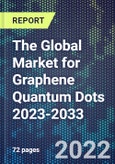Graphene quantum dots (GQDs) represent relatively new members of the carbon nanomaterials family. Studies have demonstrated that quantum confinement could appear in graphene with finite size and edge effects-graphene quantum dots (GQDs). GQDs display properties derived from both graphene and quantum dots (QDs), combining the structure of graphene with the edge effects, non-zero band gap, and quantum confinement effects of QDs. They possess unique optical and electrical properties such as:
- high quantum yield
- high electrical conductivity
- high thermal conductivity
- excellent photostability
- biocompatibility
- superior stability compared to non-carbon QDs.
- highly tunable photoluminescence (PL)
- electrochemiluminescence
- exceptional multi-photon excitation (up-conversion) property
- ease of functionalization
- low-toxicity.
As a result, they are being widely investigated for applications in optoelectronics, photonics, biomedicine, energy storage and conversion, anti-counterfeiting and sensors.
Report contents include:
- Properties of graphene quantum dots (GQDs).
- Comparison to quantum dots.
- Synthesis and production assessment.
- Applications of graphene quantum dots (GQDs).
- Addressable markets for graphene quantum dots (GQDs) including Optoelectronics, Photonics, Energy storage and conversion, Biomedicine and life sciences and Anti-counterfeiting.
- Global revenues estimated to 2033 by market.
- Market and technology challenges for graphene quantum dots (GQDs).
- Pricing.
- 14 company profiles including Dotz Nano Ltd., Green Science Alliance Co., Ltd., Quantuag Nanotechnologies and Qurv Technologies.
This product will be delivered within 1-3 business days.
Table of Contents
Companies Mentioned (Partial List)
A selection of companies mentioned in this report includes, but is not limited to:
- American Elements
- Biographene, Inc
- Carbon Upcycling Technologies
- Dotz Nano Ltd
- ENano Tec Co., Ltd
- GoLeafe
- Graphene Square
- Graphensic AB
- Green Science Alliance Co., Ltd
- KRI, Inc
- Quantag Nanotechnologies
- Qurv Technologies S.L
- Shanghai Simbatt Energy Technology Co., Ltd
- Sigma-Aldrich
Methodology

LOADING...








